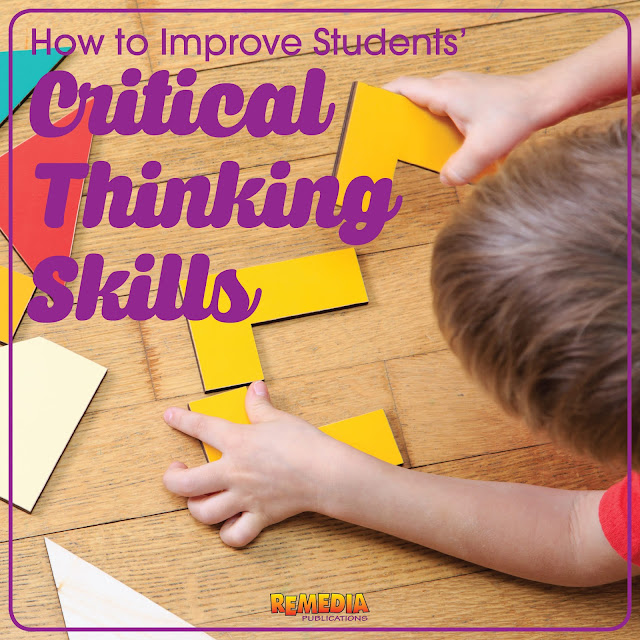Improve high-level, critical thinking skills and you're sure to improve reading comprehension, problem solving, writing skills, and more! We’ve gathered five important higher-level thinking skills, defined the skill, and suggested a way for you to help improve that skill. These tips are a terrific way to give your students the tools they need for success in school as well as in their daily lives!
USING LOGIC
As the basis of all reasoning skills, it is essential that logic be presented and stressed in as many different formats as possible. As students use logic to arrive at a conclusion, they will develop abilities in examining information, exploring possibilities, and sequencing. These same steps are required in any problem-solving situation-both academic and practical.Picture Logic
Give your students' brains a workout with this 2-page free worksheet download. Your students' problem-solving skills will soar with these Picture Logic activities.Improve critical thinking skills w/these tips from @remediapub #edchat
{ Tweet This }
DRAWING SOLUTIONS
Drawing Solutions is the skill of turning an abstract problem into a visual, semi-concrete format. This ability is an important step in the development of effective problem-solving techniques.By creating a visual representation of the components of a problem, students can more easily perform necessary operations and actually see the logic (or the absence of logic) in their solution. It simplifies the process of following a sequential order in problem-solving. It also provides a means for “talking through” the steps taken, making inconsistencies easier to detect.
Drawing Solutions in Math
Shell Education’s Think it, Show it, Mathematics has tons of suggestions for high-level thinking. The author suggests that as students solve math word problems, they should explain their process in complete sentences. For instance, students should write, “To solve the problem, I…” Once students have explained how they came to their answer, they should then write a number sentence.Bonus Tip: ask students to write a unique word problem using their number sentence. Get the book here.
 |
| Don’t let your students opt out of thinking by saying IDK. Try these alternate responses: May I have more time, more information, look it up, hear the question again, or respond in writing? |
APPLICATION
The third step in Bloom’s Taxonomy, Application, is the use of information recalled and understood. Improve this skill by having students use acquired facts and skills in new situations.Create a Plant or Flower
Ask students to apply what they have learned and now know about plants and flowers in order to expand information and create a plant or flower. Download this free worksheet that will instruct students: You are a scientist who has just discovered a new flower! Draw the plant. Label its parts. Name it...etc.RELYING ON REASON
There are five major areas of reasoning skills: analyzing real and make-believe, inferring, distinguishing between fact and opinion, making assumptions, and determining cause and effect. Since these skills involve an abstract level of thinking, it is entirely possible that students may have very valid reasons for answering questions or responding to activities differently. When practicing reasoning skills, any answer students can explain in a logical manner should be accepted.Because
For this reason, the word because is an important part of Relying on Reason. Post a sign during guided reading, class discussions, and other activities that simply says “Because...” This will help students remember to justify their thinking, opinions, and answers.
 SYNTHESIS
SYNTHESIS
The fifth level in Bloom’s Taxonomy, Synthesis, is the ability to combine parts of a whole in a new and different way. It includes the ability to think flexibly, determine alternatives, and find other ways to accomplish a given task. Not Just Any Ordinary Object
To practice synthesis, bring in several everyday, ordinary objects such as an egg carton, clothespin, clothes hanger, helmet, or book. First discuss one of the objects with the class. Then ask students to think of unique ways to use these everyday objects. With this level of abstract thinking students should be encouraged to go beyond the obvious to more original thoughts. Once students seem comfortable with coming up with ideas out loud, show students additional ordinary objects and have them write at least two ideas for unique ways to use the objects.You could even turn this activity into a project where students must take their ideas and physically transform those ordinary objects into their new uses, and present their ideas to the class.Bonus Tip: Post your “Because” sign to remind students to support their reasoning.


